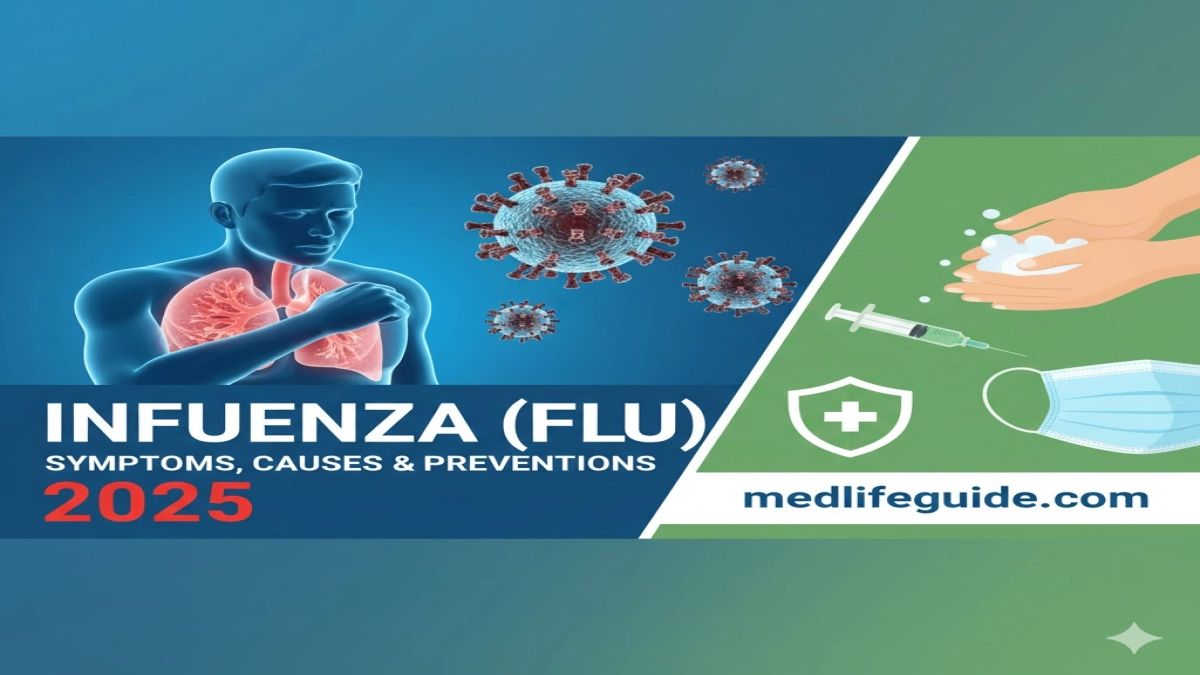Let’s dive in. I’m going to walk through what we really know about influenza (sometimes just called the flu) in 2025—how it shows up, why it happens, and what you can do about it. I’ll aim to bring you expert-level clarity without jargon, so you can use this information in real life. This is for people caring about physical health who want to understand and act, not just read a checklist.
What is influenza (flu) in 2025
Here’s the baseline: influenza is a contagious viral infection that targets the nose, throat and sometimes lungs.
But there are a few things worth emphasising for 2025:
- The illness season is still very real and impactful. According to one recent overview, this season is “the most intense in over a decade.
- The virus variants keep shifting. Even though we think we know influenza A and B, and the typical seasonal pattern, there are complications with how climate change, behaviour, and global travel affect transmission.
- Flu isn’t just “just a bad cold.” It can lead to serious complications—especially for high-risk groups.
So what this really means is: Even if you’ve had the flu before, you can’t assume this year is “no big deal”. It may present similarly, but conditions around you may make it more intense or more easily shared.
Symptoms: what to watch for
Here’s a list and then some nuance.
Common symptoms
Typical flu symptoms (for children and adults) include:
- Fever or feeling feverish / chills.
- Cough.
- Sore throat.
- Runny or stuffy nose / nasal congestion.
- Muscle or body aches, headaches.
- Fatigue / feeling very tired or weak.
- In children: vomiting or diarrhea may appear.
What makes flu different from a cold (and why that matters)
- Flu onset is usually sudden (“came out of nowhere”) compared to a cold which creeps up.
- The aches, fatigue and fever tend to be more intense.
- Some people don’t have a fever though—so absence of fever doesn’t rule it out.
Red-flags: when symptoms may indicate something serious
If you or someone you’re caring for has:
- Trouble breathing or shortness of breath
- Chest pain or pressure
- Sudden dizziness or confusion
- Persistent vomiting or inability to drink
- High fever that returns after improvement
…then you need medical attention. (Sources from general flu guidance.)
One specific recent note: in 2025 there’s concern about rare but serious brain complications (encephalitis) in children with severe flu.
Quick takeaway
If you wake up feeling utterly wiped out with fever + aches + cough, don’t assume it’s “just a cold”. The combination and intensity matter. And start thinking “flu” not “maybe later”.
Causes: how and why infection happens
Understanding how influenza spreads and why matters because that guides prevention.
The virus and how it works
- The flu is caused by viruses in the Influenza virus family (mainly types A and B for humans).
- These viruses mutate over time; that’s part of why the flu keeps coming back in different forms. (See seasonality index study)
How it spreads
- Coughs or sneezes from someone infected release droplets. If you’re close enough, you breathe them in or they land on your face/mouth/nose.
- Touching a surface contaminated by the virus (door knob, phone, computer) then touching your face.
- You’re contagious even before you feel ill—typically one day before symptoms appear—and you remain contagious for several days afterward.
Why some people get it worse
Factors that increase risk include:
- Age (very young, older adults)
- Chronic health conditions (lung disease, heart disease, diabetes)
- Weakened immune system
- Pregnancy
- Sometimes obesity.
Why this season in 2025 may matter more
- Flu activity has been reported higher than usual in many regions.
- Behaviour changes (post-COVID fatigue, less distancing, more indoor gatherings) may boost spread.
- Climate and seasonality shifts may affect when and how intensely the virus spreads.
Prevention: what you can do (and why it works)
Here’s where it gets practical. Prevention is a mix of broad strategies and individual action.
Core prevention steps
- Vaccination
- The annual flu shot remains the most important tool.
- Even if it doesn’t prevent infection entirely, it often makes the illness less severe and lowers the chance of complications.
- For 2025, getting vaccinated before or early in the season is still sound advice.
- Hygiene basics
- Wash your hands regularly (20 seconds, soap/water).
- Avoid touching your face (mouth, nose, eyes) with unwashed hands.
- Cover coughs and sneezes with a tissue or elbow. Dispose of tissues promptly.
- Clean/disinfect surfaces regularly (especially in shared spaces).
- Behavioural/Environmental measures
- Stay home when you’re sick (to protect others).
- If possible, wear a mask in crowded indoor settings or if you’re in close contact with vulnerable people.
- Improve indoor air circulation (open windows, use ventilation).
- Keep distance from people who are coughing/sneezing, especially if they’re ill.
- Lifestyle support
- Get good sleep, eat well, manage stress (since immune health is tied to overall health).
- Stay hydrated.
- If you’re in a high-risk category (pregnant, older, with chronic disease) talk to your doctor for extra precautions.
Preventive mindset for 2025-26
What’s new or emphasised for this season:
- Because of higher activity and more severe presentations, starting prevention before flu hits you is more critical than “after symptoms appear”.
- Don’t assume “I’ll skip the shot because I’m healthy” — even healthy people can suffer and transmit the virus to others.
- Internal linking idea: if you have a site page about “Vaccination advice for respiratory viruses” or “Immune-support basics”, link to it from here to deepen reader engagement.
What to do if you catch it
Let’s say you start to feel ill. Here’s how to respond.
At-home care
- Rest. Your body needs energy to fight the virus.
- Stay hydrated: water, juices, warm soup are good.
- Over-the-counter medications: acetaminophen or ibuprofen can help ease fever, aches. (Children should not be given aspirin unless a doctor says so.)
- Stay home. Minimise contact with others until you’re well.
- Use a mask if you have to be around others and practise good hygiene (cough/sneeze cover, hand washing).
When medical care is needed
- If you’re high risk (young child, older adult, chronic disease) and flu symptoms appear.
- If symptoms worsen instead of improving—particularly cough, fever, trouble breathing.
- If you suspect complications (e.g., ear infection, pneumonia, confusion).
- Antiviral medications (like Oseltamivir, Baloxavir) may be prescribed if caught early. These can shorten illness and reduce complications.
Duration & recovery
- Symptoms often start 1–4 days after exposure.
- Fever and major symptoms may last a few days to a week; cough or fatigue may persist longer.
- Full recovery—even among healthy people—may take longer than you expect, especially this season.
Causes → Symptoms → Prevention: Putting the pieces together
Here’s how the chain works and why each link matters:
- Cause: You get exposed to the influenza virus through droplet or surface contact. If you’re susceptible, the virus takes hold.
- Onset of symptoms: The virus triggers your immune system, which causes fever, aches, fatigue and the respiratory signs. The sudden onset is a hallmark.
- Transmission: While you’re symptomatic (and often before), you’re spreading virus droplets to others.
- Prevention breaks the chain:
- Vaccination reduces susceptibility and severity.
- Hygiene and masking reduce exposure and transmission.
- Staying home when sick breaks the spread to others.
- Good overall health supports your immune response.
If you understand that chain, you can pick the most effective places to intervene.
Key latent questions people often have
Here are questions readers might not ask directly, but are thinking, and we’ll answer them.
“If I had the flu last year, am I safe this year?”
No. Immunity from prior infection is helpful, but because the virus mutates and because your exposure and environment change, you’re not guaranteed safe. Annual vaccination and preventive habits matter each year.
“How do I know if it’s flu or something else (cold, COVID-19, allergy)?”
- Flu comes on faster and tends to hit harder.
- Loss of taste/smell is more typical of COVID-19; sneezing/runny nose more typical of allergy.
- Testing may help to distinguish.
- If you’re not sure and symptoms are significant, treat as if it could be flu and seek care, especially if high risk.
“Can I skip the vaccine if I’m healthy?”
You can, but skipping increases your risk of getting flu, of spreading it to others and potentially of complications you might not expect. The vaccine also helps reduce burden on hospitals. So it’s a good decision to vaccinate.
“Are masks and hand-washing actually helpful?”
Yes. While they don’t eliminate all risk, they significantly reduce transmission opportunities. Particularly important indoors or in proximity to vulnerable groups.
“Why is the outcome more serious this year?”
It may be a combination of higher baseline virus activity, behavioural changes (more indoor gatherings, less vigilance post-COVID), and environmental or climate factors that shorten the usual ‘flu season’ boundaries. Research on new indices shows seasonality is shifting.
Actionable take-aways you can apply right now
- If you haven’t already this season, book your flu shot as soon as possible.
- Keep up good hygiene habits—hand-washing, cough etiquette, clean surfaces.
- If you feel unwell with flu‐type symptoms, stay home and minimise contact with others (especially kids, older adults, immunocompromised).
- Monitor your condition—if you’re high risk or symptoms worsen, contact your healthcare provider early (antivirals work better when started early).
- Link to internal resources:
- A page on “Respiratory vaccine schedules 2025-26”
- A page on “When to seek medical help for respiratory illness”
- A page on “Supporting immune health year-round”
- If you run a health site or blog: consider adding personal stories (e.g., a case where someone delayed vaccination and got severe flu) or proprietary data (e.g., local vaccination rates) to enhance trust and demonstrate real-world experience
Final thoughts
Here’s the bottom line: Influenza in 2025 is not something to assume you’ll shrug off. The combination of heightened activity, shifting patterns, and the ripple effects of global health behaviour mean you should treat it with informed respect. But the good news is you have tools. Vaccine, hygiene, awareness—they work.
Take action. Protect yourself, your household, your community. And if you want, we can drill down further: for example, analyse the flu strains dominant in South Asia (or Pakistan), compare vaccine uptake statistics locally, or lay out a detailed prevention checklist specific to workplaces or schools.

